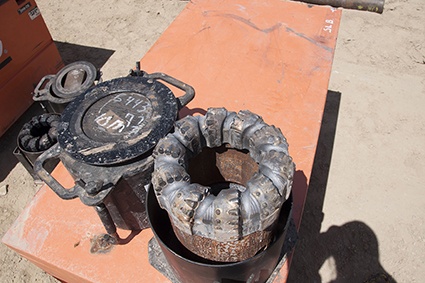 The BSCSP field team has made substantial progress on the monitoring well since drilling began on May 19. Over the next five days, the team drilled the main hole down to a depth of 3,661 feet, the target destination for extracting the first core samples.
The BSCSP field team has made substantial progress on the monitoring well since drilling began on May 19. Over the next five days, the team drilled the main hole down to a depth of 3,661 feet, the target destination for extracting the first core samples.
As described in previous blog posts, the “coring” process involves extracting long cylinders of rock, which are studied for their geologic properties. The first core was a 30 foot sample from the Potlatch Formation, which consists of dense, anhydrite rock. This layer will serve as a secondary layer of cap rock above the carbon dioxide (CO2) injection zone.
From there, the team drilled ahead approximately 200 feet to reach another section targeted for more extensive coring. Starting at a depth of 3,904 feet, the team cored a continuous section of 240 feet. The process, which took three full days to complete, was conducted by extracting four samples, each in 60 foot core barrels. By capturing samples from such a long segment of the well, researchers will be able to carefully analyze the complex geology of the CO2 injection zone, which includes layers of cap rock as well as zones of high porosity and permeability. This will help BSCSP pinpoint the optimal for injection and monitoring activities.
When the coring was complete, the team continued drilling approximately 550 feet, reaching the total, final depth of 4,700 feet on May 28. With the primary drilling finished, the next tasks on this well will include logging (a measurement process), lining the hole with pipe, and cementing the well surfaces.
